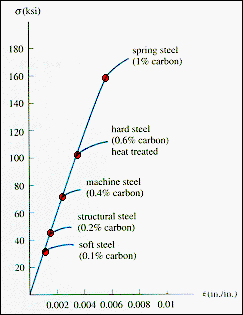| |
Materials
Modification
Structural materials are seldom used in their pure elemental
form. Since the Bronze Age mixtures of elements have been used to improve
the performance of a material in a specific application. Bronze is an alloy
of copper and tin with a very complex array of possible compositions. Both
of the elements are relatively soft and have low melting points. The atoms
of one element can substitute for those of the other when they are alloyed to
form a bronze. The bronze is less ductile than either of the constituting
elements and its properties can be controlled over some range by selecting the
composition of the alloy.
The diagram shows the effect of carbon content
on a carbon-iron alloy (a carbon steel). The stress-strain curve shows
that the addition of carbon to the iron in amounts up to 1% by weight has little
effect on the elastic constant (Young's modulus) of the alloys, however,
it does have an important effect on the alloy's yield stress, sy. The yield stress increases in value as the carbon
content is increased and additional factors such as heat treatment can also
alter its value. (1 ksi = 1000 psi = 6.9 MPa) |
|
|
|
|
|
|
|
|
|
|
|

